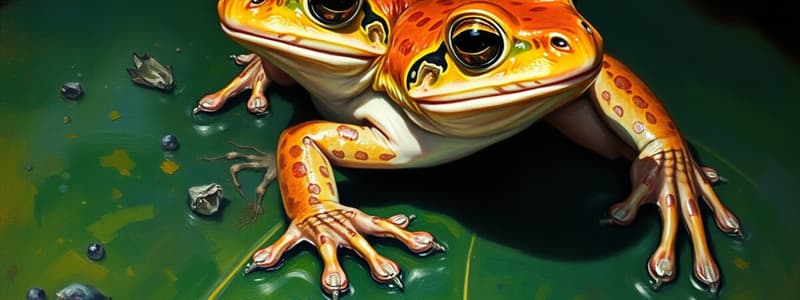Podcast
Questions and Answers
What are the characteristics of amphibians?
What are the characteristics of amphibians?
- Excrete ammonia
- Respiration through gills, lungs, and skin (correct)
- Skin is smooth and moist (correct)
- Have scales
What defines the Order Apoda?
What defines the Order Apoda?
Caecilians
What is unique about the Order Caudata?
What is unique about the Order Caudata?
Includes salamanders and newts
Tropical breeding involves laying eggs in water.
Tropical breeding involves laying eggs in water.
What is neotony?
What is neotony?
What distinguishes the Order Anura?
What distinguishes the Order Anura?
Toads usually require water to breed.
Toads usually require water to breed.
In adaptations for jumping, amphibians have a short __________ column.
In adaptations for jumping, amphibians have a short __________ column.
What is a primary feeding adaptation in amphibians?
What is a primary feeding adaptation in amphibians?
Temperate breeding involves parental care of eggs.
Temperate breeding involves parental care of eggs.
Flashcards are hidden until you start studying
Study Notes
General Characteristics of Amphibians
- Amphibians include caecilians, frogs, toads, and salamanders.
- Skin is smooth and moist, lacking scales, with glandular properties.
- Possess a large mouth with teeth; may have varying limb structures (four, two, or no limbs).
- Respiratory methods include gills, lungs, and skin absorption.
- Have a three-chambered heart with two atria and one ventricle.
- Excrete urea as a waste product.
Order Apoda
- Comprises caecilians, which are worm-like and lack limbs.
- Adapted for burrowing, with small or absent eyes, often blind.
- Typically found in tropical regions, feeding on small invertebrates.
Order Caudata
- Encompasses salamanders and newts, characterized by their tails.
- Some aquatic species may have lost hind limbs.
- Habitat includes both aquatic and moist terrestrial environments.
- Larval stages possess gills, while some adults are lungless and carnivorous.
Tropical Breeding Strategies
- A trend to lay eggs on land or in small bodies of water to reduce predation threat.
- Involves parental care for eggs and tadpoles.
- Some species undergo direct development, bypassing the aquatic tadpole stage.
Salamanders
- Southern Appalachians boast a high diversity of salamanders due to cooler temperatures, cold water, and forest environments.
- They serve as important predators within woodland ecosystems in eastern North America.
- Eggs can be laid in water or on land, allowing some species to skip the tadpole stage.
Neotony
- A phenomenon where certain species, like mudpuppies, retain larval characteristics throughout adulthood.
- Typically found in aquatic species.
Order Anura
- This order includes frogs and toads, recognized as the most specialized and successful amphibian group.
- Adults lack tails and exhibit a larval stage known as tadpoles.
- Notable for large eyes and adaptability to both aquatic and terrestrial environments.
Toads
- More adapted to terrestrial life compared to frogs.
- Skin features bumps and large parotid glands which secrete toxins.
- Despite being terrestrial, water is still necessary for breeding.
Adaptations for Jumping
- Anatomical features include a short vertebral column and an enlarged pelvic girdle.
- Long hind limbs equipped with large leg muscles facilitate powerful jumps.
- A light skull structure helps minimize weight.
- Forelimbs are adapted to absorb weight during landing.
Feeding Habits
- Amphibians are primarily carnivorous, preying on a variety of invertebrates.
- The tongue is attached to the front of the mouth, allowing it to flip out quickly, with a sticky glandular tip.
- Tadpoles typically exhibit herbivorous dietary habits.
Temperate Breeding Patterns
- Males establish territories in spring and call to attract females, leading to amplexus (mating embrace).
- They lay jelly-like eggs in water without providing parental care.
- Offspring emerge as aquatic tadpoles.
Studying That Suits You
Use AI to generate personalized quizzes and flashcards to suit your learning preferences.




